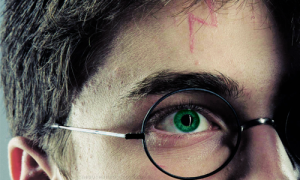“Scars can come in handy. I have one myself above my
left knee that is a perfect map of the London Underground.”
–Albus Dumbledore, Harry Potter & the Sorcerer’s Stone
Well, there’s no sense hiding it: I’m a bit of a Harry Potter geek. To prepare for yesterday’s release of the final movie installment, I took it upon myself to reread all seven of the books over the past four weeks. It was a lot of pages to read in a fairly short timeframe. It all cumulated in my reading of over 600 pages yesterday, followed by seeing the movie late last night. In addition, with the boards looming ever nearer, I’ve been doing at least 100 review questions every day, and going over topics that I want to refresh on (seriously, renal stuff just won’t stick in my brain.). Between Harry and the NCLEX, my days became a blur of hippogriffs, glomerulonephritis, electrolyte imbalances, and horcruxes. I once caught myself mentally scolding Madame Pomfrey for “not using therapeutic communication” with her spell-stricken patients.
I grew up with the Harry Potter series– I read the first book when I was 11 years old, graduated high school as the seventh one came out, and now here I am freshly graduated from college as the final movie premiered. Reading it this time around, though, I had a different perspective. I was looking for closure– both for the characters and myself– and rather than reading it with the eagerness of an 11 year old seeking a story, I was reading it for broader meanings. I was relating to it in a new way.
 In the series, Harry Potter’s scar serves as a physical proof of what he survived, a symbol of his mother’s protection, and a reminder of what he had to do. Scars are proof that struggles leave marks. Whether the mark comes from a fall off a bike, a surgery, or a failed Killing Curse from a dark wizard… Scars are proof that a person has lived through something. They represent healing, protection from further harm. The tissue hardens but the wound closes. And once a scar is there, it is up to the person to decide whether to be ashamed or proud of the mark.
In the series, Harry Potter’s scar serves as a physical proof of what he survived, a symbol of his mother’s protection, and a reminder of what he had to do. Scars are proof that struggles leave marks. Whether the mark comes from a fall off a bike, a surgery, or a failed Killing Curse from a dark wizard… Scars are proof that a person has lived through something. They represent healing, protection from further harm. The tissue hardens but the wound closes. And once a scar is there, it is up to the person to decide whether to be ashamed or proud of the mark.
In nursing we see scars a lot. Patients sometimes need help coming to terms with a fresh scar; others collect them as testaments to their past. I had a patient once show me her scar running the length of her back, from a previous spinal fusion to treat scoliosis. She was happy with the mark, she said, because it gave her the chance to share her story with anyone who might question her about it. This summer I’ve acquired some scars of my own– much smaller ones, really only noticeable if pointed out– but I like seeing them. They dot my left arm, “track marks” from the stem cell donation I made for a patient with non-Hodgkin’s lymphoma through the national bone marrow registry. I love them for the story they tell, and for the chance they give me to spread the word about being a donor. For me they are a sign of healing that runs much deeper than the IV access sites; the process reshaped how I think about a lot of things.
Like the Dumbledore quote above states, scars can serve a variety of purposes for different people. We cannot separate ourselves from our past; it becomes a part of us and shapes who we will become. Perhaps not as literally as in Dumbledore’s case, these scars do serve as a guide for our future. How we interpret that guidance is still up to us, and I hope to be able to use mine in a way that will help my future patients write their own story through their scars.